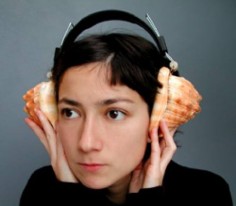SU-MEI TSE
source: artasiapacific
Luxembourg-born Su-Mei Tse rose to international prominence at the age of 30 when she won the Golden Lion prize for her country’s pavilion at the 2003 Venice Biennale. Born to a British pianist mother and a Chinese violinist father, Tse studied music and plays the cello. Naturally, her work relates to music and a variety of aural cues-—whether musical instruments, the sound of street sweepers or no sound at all as in her soundproof room, Chambre Sourde (2003), in which visitors only hear their own breathing. Tse’s show at Contemporary Art Gallery, Art Tower Mito, her first solo show in Japan, follows these same lines, full of musical associations and intellectual yet light-hearted displays.
Das Wohltemperierte Klavier (Well-Tempered Clavier, 2001) is a video projection piece based on German composer JS Bach’s famous set of 48 keyboard preludes and fugues for a solo performer. Tse’s video shows a close-up of a pianist’s hands trying to play a piece from Bach’s collection with thin pieces of wood taped to the bottom and top of each finger. The action resembles playing the piano with finger prostheses, but the fingers stubbornly keep moving and running over the keys, missing the correct notes. It reminds us of the training required to master an instrument, and the work can be read as a metaphor for conquering one’s own doubts in order to achieve greatness.
Tse features her signature instrument in L’Echo (2003), which premiered in the 2003 Luxembourg Pavilion. A large video projection shows the artist playing the cello on a lush mountainside in the Alps. She wears a red costume, and the saturated green of the mountain grass and the dark-gray cliff beyond her create a deliberately over-dramatized picture composition. At the same time, the melody she plays echoes off the mountain, creating a tune that falls out of sync with what she is playing as, curiously and humorously, the mountain appears to be accompanying her.
Other displayed pieces do not use sound but drive the viewer to imagine it. A sculptural work SUMY (2001), made in collaboration with her partner Jean-Lou Majerus, is a pair of light-brown seashells enclosed in a transparent resin cube with a red cloth connecting two ear-pieces that together resemble a pair of headphones. The title is a clever mingling of the artist’s name and Sony; the shells evoke the aural phenomenon of hearing the ocean in a seashell.
Tse also reprised her works that reference international social and cultural variances, and made them Japan-specific. The installation work Standard Eye Level (2006) consists of a number of bonsai plants, each of which is placed on a steel camera tripod, and a horizontal line of fluorescent orange tape stuck on the gallery walls. The plants originated in Japan, China, Europe and Oceania, and Tse adjusts the height of the tripods depending on the standard eye-level of the residents from the country where the work is being exhibited. It can be interpreted as the artist’s statement that every country has its own “standard” and it varies from one to another, a fact that is made somewhat sinister by Tse’s use of bonsais, which only grow in a precise, constrained manner. A similar point is illustrated in Dong Xi Nan Bei (E, W, S, N, 2006), an installation of four neon Chinese characters signifying each cardinal point, here arranged according to Japan’s azimuth direction.
The diversity of Tse’s work makes it difficult to categorize her. What ties all the works together is the gentle but humorous manner in which she expresses a range of her interests through her work, quite different from an earlier cellist-artist, Charlotte Moorman, famous for her controversial, confrontational and often nude performances in the 1960s—many of which were collaborations with Nam June Paik. Tse is well aware that a simple, musical solo can be more affecting than an eccentric and scandalous act
of musical performance.
.
.
.
.
.
.
.
.
source: premierregard
Su-Mei TSE
Née en 1973 à Luxembourg, vit e travaille entre Paris et Luxembourg
ETUDES
2000 Diplôme d’Arts Plastiques avec les félicitations du Jury, Ecole Nationale Supérieure des Beaux Arts de Paris
1996 Diplôme de BTS textile et impression, Ecole Nationale des Arts Appliqués, Paris
1993-1999 Conservatoire de Musique, Paris VI
1991 1er pris de violoncelle, 1er pris en musique de chambre, Conservatoire de Musique de la Ville de Luxembourg
PRIX
2003 Lion d’Or pour la meilleure Participation Nationale, 50e Biennale de Venise
2001 Prix d’art Robert Schuman


